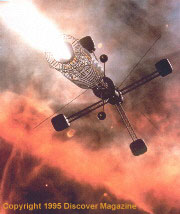Article/Document:
Warp drive possible
BBC News, June 10, 1999
original source | fair use notice
Summary: In Star Trek, the USS Enterprise is powered by what is called a "warp drive" and at the moment only Paramount Pictures know its secrets. But new, highly mathematical research may have brought us one step closer to being able to explore the Universe in a starship capable of travelling faster than the speed of light.
By BBC News Online Science Editor Dr David Whitehouse
In Star Trek, the USS Enterprise is powered by what is called a "warp drive" and at the moment only Paramount Pictures know its secrets.
But new, highly mathematical research may have brought us one step closer to being able to explore the Universe in a starship capable of travelling faster than the speed of light.
The analysis of the concept of a warp drive by Chris Van Den Broeck of the Catholic University in Leuven, Belgium means that building a starship Enterprise is a little closer.
The fabric of space
Dr Van Den Broeck was reanalysing ground-breaking calculations made five years ago by Mexican mathematician Miguel Alcubierre.
Alcubierre said that it was possible to imagine how a warp drive would work by distorting the fabric of space. Starships would ride along waves in so-called spacetime, like surfers do along waves in the sea.The idea relies on the concept that, to physicists, space is not empty. Strange as it may seem, space has a shape that can be distorted by matter. In fact the force of gravity is actually due to the curvature of space - recognising that was the greatest triumph of Albert Einstein's career.
So you could use matter to distort the space around a starship to create a "ripple" in spacetime.
The starship would have to be microscopically small on the outside but large enough on the inside to carry passengers, just like the Tardis in the British sci-fi series, Dr Who.
'Warp bubble'
Miguel Alcubierre came up with the idea of expanding the space behind a starship and contracting it in front of it. The starship would rest in a "warp bubble" between the two spacetime distortions. The result would be a wave in spacetime along which the starship would surf.
It was a fantastic idea. There would be no limit to the velocity that a starship could attain. It could travel faster than the speed of light because the starship would, strictly speaking, be stationary in the space of its warp bubble.
Also, the starship and its crew would be weightless and would therefore not be crushed by the enormous G-forces of acceleration and deceleration.
What's more, the passage of time inside the warp bubble would be the same as that outside it. The crew would not suffer from Einstein's "time dilation" effect where time passes at different rates for people travelling at different speeds.
The time dilation effect means that anyone travelling to the stars at speeds approaching that of light would experience a journey of a few years. But when they came back to Earth they would find that thousands of years had passed and all their friends were long dead.
Massive energies
Alcubierre's idea was a good one, but his work seemed to suggest that building a warp bubble would be impossible in practice. More energy than the entire universe could supply would be needed to create the spacetime distortions.
However, Dr Van Den Broeck's analysis suggests a far lower amount of energy is required, reduced by a factor of one followed by 62 zeros.
This is not to say that it is time to go out and start building a warp drive. As Dr Van Den Broeck says in his forthcoming paper in General Relativity and Quantum Cosmology: "This does not mean that the proposal is realistic."
Building a warp drive is currently far beyond our technological abilities and there are severe theoretical arguments that say it may never be possible.
But it just might be. Dr Van Den Broeck concludes his analysis by saying, "The first warp drive is still a long way off but maybe it has now become slightly less improbable."
Read more articles on this topic:






